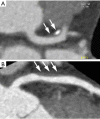Coronary CT angiography-future directions
- PMID: 29255687
- PMCID: PMC5716941
- DOI: 10.21037/cdt.2017.06.10
Coronary CT angiography-future directions
Abstract
Clinical applications of coronary CT angiography (CTA) will typically be based on the method´s very high sensitivity to identify coronary stenosis if image quality is good and if the pre-test likelihood of the patients is in the lower range. Guidelines of national and international cardiac societies are starting to incorporate coronary CTA into their recommendations for the management of patients with stable and acute chest pain. Initial data show that in the future, the use of coronary CTA may not only be able to replace other forms of diagnostic testing, but, in fact, may improve patient outcome. In this article, a perspective is provided on the future directions of coronary CTA.
Keywords: Coronary CT angiography (CTA); cardiac; flow; plaque.
Conflict of interest statement
Conflicts of Interest: The author has no conflicts of interest to declare.
Figures




References
-
- Chinnaiyan KM, Boura JA, DePetris A, et al. Advanced Cardiovascular Imaging Consortium Coinvestigators Progressive radiation dose reduction from coronary computed tomography angiography in a statewide collaborative quality improvement program: results from the Advanced Cardiovascular Imaging Consortium. Circ Cardiovasc Imaging 2013;6:646-54. 10.1161/CIRCIMAGING.112.000237 - DOI - PubMed
LinkOut - more resources
Full Text Sources
Other Literature Sources
